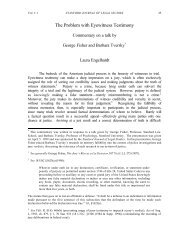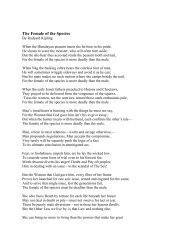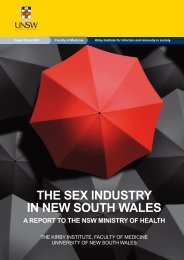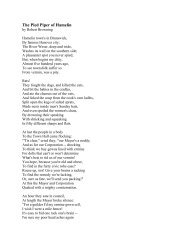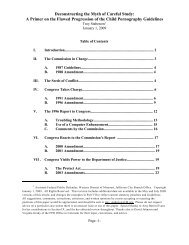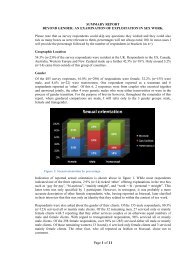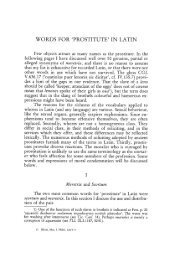A Commentary on “Challenging Men's Demand for Prostitution
A Commentary on “Challenging Men's Demand for Prostitution
A Commentary on “Challenging Men's Demand for Prostitution
You also want an ePaper? Increase the reach of your titles
YUMPU automatically turns print PDFs into web optimized ePapers that Google loves.
A <str<strong>on</strong>g>Commentary</str<strong>on</strong>g> <strong>on</strong> ‘Challenging Men’s <strong>Demand</strong> <strong>for</strong> Prostituti<strong>on</strong> in<br />
Scotland’: A Research Report Based <strong>on</strong> Interviews with 110 Men<br />
who Bought Women in Prostituti<strong>on</strong>, (Jan Macleod, Melissa Farley,<br />
Lynn Anders<strong>on</strong>, Jacqueline Golding, 2008)<br />
Dr Teela Sanders, Sociology, University of Leeds<br />
Dr Jane Scoular, Reader in Law, University of Strathclyde<br />
Dr Michael Goodyear, Department of Medicine, Dalhousie University, Canada<br />
Dr Hera Cook, Department of Modern History, University of Birmingham<br />
Dr Nicola Smith, Political Science and Internati<strong>on</strong>al Studies,, University of<br />
Birmingham, Birmingham<br />
Michelle Farley, Service Manager, SHOC (Sexual Health <strong>on</strong> Call)<br />
Hilary Kinnell, author of ‘Murder made easy: the final soluti<strong>on</strong> to prostituti<strong>on</strong>?’,<br />
Willan, Cullumpt<strong>on</strong>, (2006)<br />
Dr Jo Phoenix, Reader, Criminology, School of Applied Social Sciences, Durham<br />
University<br />
Rosie Campbell, Loughborough University<br />
Dr Phil Hubbard, Professor of Urban Social Geography, Dept of Geography,<br />
Loughborough University<br />
Jane Pitcher, independent researcher<br />
Dr Belinda Brooks-Gord<strong>on</strong>, Reader in Social Policy, Birkbeck College,<br />
University of L<strong>on</strong>d<strong>on</strong><br />
Dr Elizabeth Anne Wood, Sociology, Anthropology and Social Work, Nassau<br />
Community College, New York<br />
Dr Petra M Boynt<strong>on</strong>, Health Services Research, Department of Primary Care<br />
and Populati<strong>on</strong> Sciences, University College L<strong>on</strong>d<strong>on</strong>.<br />
Dr R<strong>on</strong> Roberts, Psychology, Kingst<strong>on</strong> University, L<strong>on</strong>d<strong>on</strong><br />
Kate Hardy, Geography, Queen Mary, University of L<strong>on</strong>d<strong>on</strong>.<br />
Dr R<strong>on</strong>ald Weitzer, Professor of Sociology, George Washingt<strong>on</strong> University, USA<br />
Lauren Casey, sex worker activist, British Columbia, Canada<br />
1
Prostituti<strong>on</strong> Alternatives Counselling Educati<strong>on</strong> (PACE), British Columbia ,<br />
Canada<br />
April 29 th 2008.<br />
The reas<strong>on</strong> that this report would not be accepted if it was subjected to ordinary<br />
academic peer review processes is not because it is biased per se but that the<br />
particular <strong>for</strong>m of bias is <strong>on</strong>e that (i) translates the social, ec<strong>on</strong>omic, political and<br />
ideological realities of commercial sex and the complexity of the relati<strong>on</strong>ships<br />
involved into more or less 'simple' questi<strong>on</strong>s of violence or lack thereof, (ii)<br />
transposes what might be ec<strong>on</strong>omic questi<strong>on</strong>s or other questi<strong>on</strong>s and realities into<br />
gender i.e. everything is the result of gender, and (iii) c<strong>on</strong>flates fundamentally<br />
different social phenomena (rape, paedophilia and other <strong>for</strong>ms of sexual violence) in a<br />
way which closes off understanding rather than opens it up.<br />
In this way, this report makes no c<strong>on</strong>tributi<strong>on</strong> to our understanding of either the<br />
'problem' or the soluti<strong>on</strong>. As to criminalising clients (and invoking the same<br />
procedures and punishments and rehabilitati<strong>on</strong> as those c<strong>on</strong>victed of very serious<br />
sexual offences such as rape and child sexual abuse) the authors of this report are<br />
seemingly ignorant of even the most basic legal principles such as the principle of<br />
proporti<strong>on</strong>ality and ignorant of the actual mechanisms through which criminal justice<br />
is dispensed. The report makes no attempt to understand either the men c<strong>on</strong>cerned or<br />
the phenomen<strong>on</strong>, to explore the determinants of behaviour or to set these within the<br />
broader cultural c<strong>on</strong>text. Rather it attempts to take complex relati<strong>on</strong>ships and impose<br />
simple models of gender and violence.<br />
This research violates fundamental principles of human research ethics in that there is<br />
no evidence of any benefit to the populati<strong>on</strong> studied. Rather the purpose of the<br />
research appears to have been to vilify the populati<strong>on</strong> of men who were chosen to be<br />
interviewed. It seems highly unlikely that the participants were ever in<strong>for</strong>med of the<br />
true nature of the research, which could well have influenced their resp<strong>on</strong>se. This sort<br />
of research is dangerous. The men who were interviewed will be able to read their<br />
comments juxtaposed with hostile comments from the investigators. It is quite likely<br />
that this could result in significant psychological damage. No evidence is supplied<br />
that the interviewees agreed to have their comments reproduced in this <strong>for</strong>m, and it is<br />
possible that they could be identified, and suffer social stigmatisati<strong>on</strong>. The research<br />
appears to have prejudged the issues, and the investigators make no attempt to<br />
disguise their c<strong>on</strong>tempt <strong>for</strong> their subjects. This hostile envir<strong>on</strong>ment is not c<strong>on</strong>ducive<br />
to objective and reproducible research. The interviewees were drawn from a group<br />
with str<strong>on</strong>g prejudices against men who buy sexual services. It is hard to imagine any<br />
research committee authorising a situati<strong>on</strong> in which two groups, as here, are placed<br />
together in what virtually c<strong>on</strong>stitutes gladiatorial c<strong>on</strong>diti<strong>on</strong>s.<br />
This research <strong>on</strong> which this report is based was not grounded in empirical research<br />
ethics or a critical, objective method of producing knowledge. There appears to be no<br />
ethics approval or peer review in terms of the design and executi<strong>on</strong> of the project.<br />
There is no evidence that participants were asked <strong>for</strong> in<strong>for</strong>med c<strong>on</strong>sent and no<br />
2
in<strong>for</strong>mati<strong>on</strong> is given regarding the ethical protocols that were followed. Similarly,<br />
though the survey methodology is described, details of the questi<strong>on</strong>s asked are not<br />
provided. It is standard practice that questi<strong>on</strong>naire instruments are included in an<br />
Appendix <strong>for</strong> scrutiny. The report was published in-house by the Women's Support<br />
Project. This is outside the normal academic peer review process and there<strong>for</strong>e it is<br />
not entirely surprising that the report is not of an acceptable academic standard.<br />
The report is based <strong>on</strong> the particular radical standpoint which holds that prostituti<strong>on</strong> is<br />
violence towards all women and that voluntary c<strong>on</strong>sensual engagement in the sex<br />
industry is not possible. This standpoint, explicitly stated in the introducti<strong>on</strong>, means<br />
that the research is shaped by this perspective, leaving no opportunity <strong>for</strong> other<br />
viewpoints to be expressed or <strong>for</strong> alternative realities other than this extreme versi<strong>on</strong><br />
of prostituti<strong>on</strong> to be valid. The problems with the disseminati<strong>on</strong> and distorti<strong>on</strong> of the<br />
findings largely, though not solely, stem from this bias in the research:<br />
1. In this report the male interviewees are cast as offenders and men who<br />
perpetrate violence against women. There is, however, no analysis of the<br />
men's criminal records, or any evidence that they have committed offences <strong>for</strong><br />
which they may have been committed and sentenced by the courts. Previous<br />
peer reviewed research would suggest that the majority of these men were law<br />
abiding citizen (Hester and Westmoreland, 2004). In additi<strong>on</strong>, the participants<br />
who were paid <strong>for</strong> their time, would clearly not have signed up to fraudulent<br />
‘research’ which depicted them as criminal sex offenders.<br />
2. It is assumed that all of the 110 interviewees who buy sex commit actual<br />
sexual violence against women. This is irresp<strong>on</strong>sible and again suggests<br />
in<strong>for</strong>med c<strong>on</strong>sent was not obtained from the participants.<br />
3. There is limited review of other research methodology with men who buy sex<br />
and in particular that research in which evidence c<strong>on</strong>trary to the investigators’<br />
known views is presented. See <strong>for</strong> instance:<br />
Grentz, S. (2005) 'Intersecti<strong>on</strong>s of Sex and Power in Research <strong>on</strong> Prostituti<strong>on</strong>: A Female<br />
Researcher Interviewing Male Heterosexual Clients', Signs: Journal of Women in<br />
Culture and Society 30(4): 2091-2113.<br />
Peng, Y. W. (2007) 'Buying Sex. Dominati<strong>on</strong> and Difference in the Discourses of Taiwanese<br />
Piao-ke', Men and Masculinities 9(3): 315-336.<br />
4. Rape myths – the assumpti<strong>on</strong>s that such negative attitudes are held by the<br />
majority of male clients is a misrepresentati<strong>on</strong> and a distorti<strong>on</strong> of the report’s<br />
own findings. It is stated <strong>on</strong> page fourteen that less than a quarter of the<br />
interview subjects (22%) made associati<strong>on</strong>s between sex workers and sexual<br />
violence. This means that the majority of men interviewed did not make these<br />
links and did not hold distorted views about sex workers ‘deserving’ sexual<br />
violence.<br />
5. In additi<strong>on</strong>, the researchers ignore established large-scale research <strong>on</strong> this<br />
topic by M<strong>on</strong>to and Hotaling (2001). This study explores the level of "rape<br />
myth acceptance" and the predictors of rape myth acceptance am<strong>on</strong>g 1,286<br />
men arrested <strong>for</strong> trying to hire street prostitutes in San Francisco (n = 950), Las<br />
Vegas (n = 254), and Portland, Oreg<strong>on</strong> (n = 82). Results indicate low levels of<br />
rape myth acceptance am<strong>on</strong>g resp<strong>on</strong>dents, although a small number of men<br />
expressed higher levels.<br />
3
M<strong>on</strong>to, M. A. and Hotaling, N. (2001) 'Predictors of Rape Myth Acceptance Am<strong>on</strong>g Male<br />
Clients of Female Street Prostitutes', Violence Against Women 7(3): 275-293.<br />
6. The report does not acknowledge that men can engage in the sex industry in a<br />
respectable, n<strong>on</strong> violent manner, or that they may be aware of the issues of<br />
exploitati<strong>on</strong> and unfair treatment of sex workers. A recent study of 50 men<br />
(Sanders, 2008) dem<strong>on</strong>strated that some men who engage with sex workers<br />
are aware of issues relating to giving over m<strong>on</strong>ey to third parties, are<br />
c<strong>on</strong>cerned about exploitati<strong>on</strong> by brothel owners and coercive working<br />
practices, particularly of n<strong>on</strong>-nati<strong>on</strong>als and there<strong>for</strong>e bought sex mindful of<br />
these issues. Suggesting that all men who buy sex from women are not<br />
resp<strong>on</strong>sible is vastly over generalising assumpti<strong>on</strong>s and making inferences that<br />
do not stand up in people’s lived realities.<br />
7. C<strong>on</strong>ceptualising sex work unproblematically as violence against<br />
women invisibilises the large number of female clients of sex workers as well<br />
as male and transgender sex workers. Similarly, the c<strong>on</strong>tinued use<br />
of discourses of ‘prostituti<strong>on</strong>’ and ‘prostitutes’ denies the right to selfdeterminati<strong>on</strong><br />
and identity <strong>for</strong>mati<strong>on</strong> to individuals and groups who are<br />
mobilising in Scotland and across the world <strong>for</strong> recogniti<strong>on</strong> that they are<br />
sentient subjects able to articulate their own interests and needs. Not <strong>on</strong>ly is<br />
this lack of recogniti<strong>on</strong> dangerous and unhelpful, it is also profoundly<br />
disrespectful.<br />
8. The researchers not <strong>on</strong>ly advocate the criminalisati<strong>on</strong> of men who buy sex, but<br />
they suggest such men should be categorised as sex offenders, include placing<br />
them <strong>on</strong> the sex offender register. In the report men who buy sex are<br />
categorised with ‘rapists, paedophiles and other social undesirables’ (pp 27).<br />
This extreme view discounts the following important realities:<br />
a. The majority of commercial sexual interacti<strong>on</strong>s are without violence or<br />
robbery<br />
b. The majority of commercial sexual interacti<strong>on</strong>s are c<strong>on</strong>sensual between<br />
adults.<br />
c. There is ample counter evidence (such as Bernstein, 2001;2007) that<br />
indicate that clients are 'normal' and increasingly seeking 'authenticity',<br />
intimacy and mutuality rather than trying to fulfil any mythology of<br />
violent, n<strong>on</strong>-c<strong>on</strong>sensual sex.<br />
d. Certain groups of men, such as those living with disabilities, would be<br />
marginalised as rapists following the distorted logic of this report.<br />
e. Advocating sending men to jail vastly misunderstands the use of the<br />
criminal justice system and the issues of overcrowding.<br />
f. Penal sancti<strong>on</strong>s <strong>for</strong> buying sex has serious human rights implicati<strong>on</strong>s<br />
g. Criminalising men who pay <strong>for</strong> sex in any capacity has a significantly<br />
damaging effect <strong>on</strong> sex workers and there<strong>for</strong>e, as a policy, increases<br />
violence against women.<br />
9. There is a lack of understanding of the research d<strong>on</strong>e <strong>on</strong> men who buy sex<br />
including important works in recent years:<br />
Brooks-Gord<strong>on</strong>, B. (2005) 'Clients and Commercial Sex: Reflecti<strong>on</strong>s <strong>on</strong> Paying the Price: A<br />
C<strong>on</strong>sultati<strong>on</strong> Paper <strong>on</strong> Prostituti<strong>on</strong>', Criminal Law Review: 425-443.<br />
4
— (2006) The Price of Sex: Prostituti<strong>on</strong>, Policy and Society: Willan Publishing.<br />
Campbell, R. (1998) 'Invisible Men: Making Visible Male Clients of Female Prostitutes in<br />
Merseyside', in J. Elias, V. Bullough, V. Elias and G. Brewer (eds) Prostituti<strong>on</strong>. On<br />
Whores, Hustlers and Johns, New York: Prometheus Books. pp. 155-171<br />
Campbell, R. and Storr, M. (2001) 'Challenging the Kerb Crawler Rehabilitati<strong>on</strong> Programme',<br />
Feminist Review 67(Spring): 94-108.<br />
Kinnell, H (2006) 'Clients of Female Sex Workers: Men or M<strong>on</strong>sters?' in R. Campbell and M.<br />
O'Neill (eds) Sex Work Now, Cullumpt<strong>on</strong>:Willan. pp. 212-262<br />
Lowman, J., and Atchis<strong>on</strong>, C., (2006) 'Men Who Buy Sex: A Survey in the Greater<br />
Vancouver Regi<strong>on</strong>al District', Canadian Journal of Sociology and Anthropology<br />
43(3): 281-296.<br />
O'C<strong>on</strong>nell Davids<strong>on</strong>, J. (2003) ''Sleeping with the Enemy'? Some Problems with Feminist<br />
Aboliti<strong>on</strong>ist Calls to Penalise Those Who Buy Commercial Sex', Social Policy and<br />
Society 2(1): 55-64.<br />
Phoenix, J. and Oert<strong>on</strong>, S. (2005) Illicit & Illegal. Sex, Regulati<strong>on</strong> and Social C<strong>on</strong>trol,<br />
Cullompt<strong>on</strong>: Willan.<br />
Perkins, R. (1999) ‘How much are you love?’ The customer in the Australian sex industry.<br />
Social Alternatives 18(3) 38-47<br />
Sanders, T (2008) Paying <strong>for</strong> Pleasure: Men who Buy Sex, Willan, Cullompt<strong>on</strong><br />
Scoular, J. (2004) 'Criminalising 'Punters': Evaluating the Swedish Positi<strong>on</strong> <strong>on</strong> Prostituti<strong>on</strong>',<br />
Journal of Social Welfare and Family Law 26(2): 195-210.<br />
Van Brunschot, E. G. (2003) 'Community Policing and "John Schools"', Canadian Review of<br />
Sociology and Anthropology 40(2): 215-232.<br />
10. The study interviewed a selecti<strong>on</strong> of men who resp<strong>on</strong>ded to the newspaper<br />
advertisements. The researchers make an unjustifed assumpti<strong>on</strong> that the<br />
subjects are representative of men who buy sex in general, and that they are<br />
distinguishable from the populati<strong>on</strong> as a whole. There is neither a c<strong>on</strong>trol<br />
group, nor any attempt to compare their sample to populati<strong>on</strong> data. The views<br />
expressed by these men could easily be representative of men in general of<br />
similar age and socioec<strong>on</strong>omic characteristics. Previous research that suggests<br />
that men who buy sex are in fact indistinguishable from the general populati<strong>on</strong><br />
is ignored.<br />
11. The report makes a series of recommendati<strong>on</strong>s based <strong>on</strong> these interviews<br />
which completely ignores the basis and workings of the criminal justice<br />
system, and in particular the nature of sexual offences<br />
12. The researchers were defined as people wanting to end violence against<br />
women - but presumably this may introduce bias into how the research was<br />
run. If you are asking some<strong>on</strong>e to disclose buying sex but you openly disagree<br />
with this how can you hear what they say? This poses risk to both participant<br />
and researcher, and presumably the wellbeing of both is compromised by<br />
hiring researchers in this way. Why wasn't this assessed by the funding<br />
body/ethics committee? If researchers were traumatised then a proper risk<br />
assessment may well not have been completed at the start of the study. Such<br />
standard practice is there to minimise this problem and offer support to those<br />
in the study. The study appears to have neglected the safety and wellbeing of<br />
participants and researchers - although there is adequate evidence <strong>on</strong> how to<br />
do safe research with sensitive subjects. While a reflexive analysis is useful,<br />
opening any report stating how traumatised the researchers were is a shocking<br />
5
misrepresentati<strong>on</strong> of findings and a basic admissi<strong>on</strong> of poor research<br />
management.<br />
6





